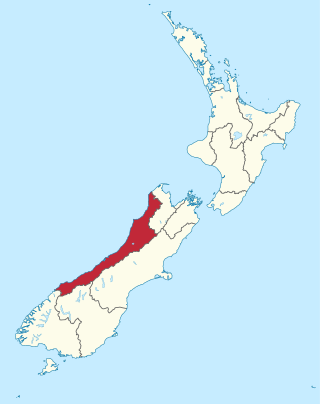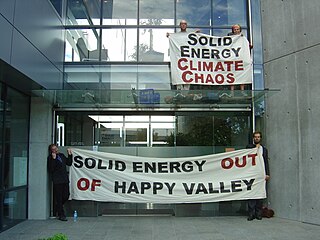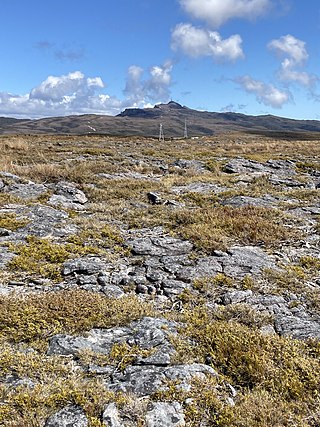Related Research Articles

The West Coast is a region of New Zealand on the west coast of the South Island that is administered by the West Coast Regional Council, and is known co-officially as Te Tai Poutini. It comprises the territorial authorities of Buller District, Grey District and Westland District. The principal towns are Westport, Greymouth and Hokitika. The region, one of the more remote areas of the country, is also the most sparsely populated. With a population of just 32,900 people, the West Coast is the least populous region in New Zealand. The population in the region grew by 0.4% over the year to July 2023.

Tree sitting is a form of environmentalist civil disobedience in which a protester sits in a tree, usually on a small platform built for the purpose, to protect it from being cut down. Supporters usually provide the tree sitters with food and other supplies.
Forest & Bird, also known by its formal name as the Royal Forest and Bird Protection Society of New Zealand, is an environmental organisation specialising in the protection and conservation of New Zealand's indigenous flora and fauna and unique wild places and natural ecosystems. Forest & Bird consists of 47 branches located in urban and rural centres throughout New Zealand. Branches are actively engaged in conservation projects and advocacy on a community, regional and national basis. Forest & Bird has offices and staff located in Auckland, Christchurch, Wellington, Nelson and Dunedin. Forest & Bird publishes a quarterly magazine Forest & Bird, one of New Zealand's definitive natural history and conservation publications.

Paparoa National Park is on the west coast of the South Island of New Zealand.
This is a timeline of environmental history of New Zealand. It includes notable events affecting the natural environment of New Zealand as a result of human activity.

The Australian Conservation Foundation (ACF) is Australia's national environmental organisation, launched in 1965 in response to a proposal by the World Wide Fund for Nature for a more co-ordinated approach to sustainability.

The Save Happy Valley Coalition (SHVC) is an environmental activist movement formed with the express purpose of preventing the Cypress mine, an open cast coal mine on the West Coast of New Zealand, from proceeding.
Solid Energy was the largest coal mining company in New Zealand and is a state owned enterprise of the New Zealand Government.

Powelliphanta augusta or the Mount Augustus snail, previously provisionally known as Powelliphanta "Augustus", is a species of large, carnivorous land snail, a terrestrial pulmonate gastropod mollusc in the family Rhytididae. Naturally occurring only on Mount Augustus near Westport on New Zealand's South Island, their entire habitat was destroyed by coal mining. The world population was taken into captivity, in theory until their habitat was restored and they could be released. The mining company concerned went bankrupt and habitat restoration has been unsuccessful, so the species' future is uncertain.
The Pike River Mine is a coal mine formerly operated by Pike River Coal 46 km (29 mi) north-northeast of Greymouth in the West Coast Region of New Zealand's South Island. It is the site of the Pike River Mine disaster that occurred on 19 November 2010, leading to the deaths of 29 men whose remains have not been recovered. The mine and its assets are owned by the Department of Conservation, whom, on 1 July 2022, assumed ownership and management following the dissolution of the Pike River Recovery Agency. The former mine site and its surrounding land are a part of Paparoa National Park.
The Mokihinui Hydro was a proposed hydroelectric dam and power station planned for conservation land on the Mōkihinui River on the West Coast of New Zealand. The project by Meridian Energy was expected to cost $300 million.

Mining in New Zealand began when the Māori quarried rock such as argillite in times prior to European colonisation. Mining by Europeans began in the latter half of the 19th century.
The Ngakawau Restoration Project is a proposed hydro scheme planned to divert acid mine drainage from coal mines to an ocean outfall to restore water quality of the Ngākawau River, in the northern section of the West Coast of the South Island of New Zealand. The project is a configuration of the Stockton Plateau Hydro Scheme being developed by Hydro Developments (2013) Limited. Project information can be found at https://hydrodevelopments.co.nz
The Pike River Mine disaster was a coal mining accident that began on 19 November 2010 in the Pike River Mine, 46 km (29 mi) northeast of Greymouth, in the West Coast region of New Zealand's South Island following a methane explosion at approximately 3:44 pm. The accident resulted in the deaths of 29 miners.

Denniston Plateau is an 18 km long, 600–800 m high coalfield plateau in the Papahaua Range on the West Coast of the South Island of New Zealand. A combination of impermeable rock, high rainfall, and shallow acidic soil has created a unique ecosystem of stunted trees and heath-like vegetation which is home to numerous endemic and undescribed species of plants and invertebrates. The plateau contains rich seams of high-quality coal, which led to the creation and abandonment of the mining towns of Denniston and Millerton, and the current Stockton Mine. Plans to create a new open-cast mine on the southern part of the plateau have become an environmental controversy.
The Escarpment Mine Project is an opencast coal mine at the Mount Rochfort Conservation Area on the Denniston Plateau on the West Coast of New Zealand in the vicinity of the disused Escarpment Mine. Bathurst Resources Limited intended to extract and export between one and four million tonnes of coal a year from open cast mining in an area of 200 hectares of conservation land on the southern Denniston Plateau. The mine would be the second largest opencast coal mine in New Zealand after Solid Energy's Stockton Mine on the Stockton Plateau. Environmental groups such as Forest and Bird and the West Coast Environment Network opposed the project.

The Carmichael coal mine is a coal mine in Queensland, Australia which produced its first shipment of coal in December 2021.
Arctesthes avatar, commonly known as the avatar moth or the Denniston triangle moth, is a moth of the family Geometridae and is endemic to New Zealand. It has been found in short-lived wetlands at elevations between 640 and 1000 metres, but only in the areas of the Denniston Plateau and the nearby Mount Rochfort in the Buller District of the West Coast Region of the South Island. The species was discovered by Brian Patrick in 2012, during a bio-blitz on the Denniston Plateau organised by Forest & Bird as part of a campaign against the planned development of an open-cast coal mine by Bathurst Resources. The name of the new species was proposed in 2012, following a competition run by Forest & Bird and judged by Patrick and his son. It was first described by Brian H. Patrick, Hamish J. H. Patrick and Robert J. B. Hoare in 2019. A. avatar has Nationally Critical conservation status under the New Zealand Threat Classification System.
Allan John Birchfield is a coal and gold miner from the South Island's West Coast of New Zealand. He is a West Coast Regional Councillor who served as chairperson from 2019 to 2023. He is known for his climate change denial.

Coromandel Forest Park is a protected area and conservation park administered by the Department of Conservation, covering 71,899 hectares of the Coromandel Peninsula, in the Thames Coromandel District of the Waikato Region.
References
- ↑ "Buller Conservation Group Incorporated". opencorporates.com. Retrieved 19 January 2021.
- ↑ McNamara, Patrick John (25 January 2008). "Interview with Pat McNamara". National Library of New Zealand. Retrieved 19 January 2021.
- ↑ "NZCA's advice on the Kahurangi National Park proposed addition of the Mokihinui River Catchment". Department of Conservation. 28 June 2017. Archived from the original on 28 January 2021. Retrieved 19 January 2021.
- ↑ "Native Forest Action". www.apc.org.nz. Retrieved 19 January 2021.
- ↑ "New Zealand Court Approves Coal Mine in Kiwi Territory". ens-newswire.com. 26 May 2005. Archived from the original on 15 May 2006. Retrieved 19 January 2021.
- ↑ "Westport mining battle". New Zealand Herald. 15 December 2003. Retrieved 19 January 2021.
- ↑ Mussen, Deidre (29 October 2012). "Court to decide fate of West Coast mine". Stuff. Retrieved 19 January 2021.
- ↑ "'Greenie' on alert for bomb in the window". New Zealand Herald. 12 April 2006. Retrieved 19 January 2021.